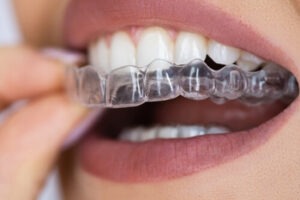Thinking about straightening your teeth with Invisalign? One of the first things that comes to mind is the cost. The price of treatment can be different for everyone, and several things play a role in how much you might pay. So, how much does Invisalign cost? The answer depends on a few important factors that shape the overall expense. Knowing what affects the cost can help you plan and make the best decision for your smile. Let’s explore what goes into the price and what to expect when choosing this treatment.
What Is Invisalign?
Invisalign is a way to adjust teeth using clear trays that fit over them. These trays are made to gently move teeth over time. Since they are see-through, they are not easily noticed when worn. Each set is designed to help teeth shift into a better position.
What Is the Cost of Invisalign?
The starting price for Invisalign in Australia is around $6000, though the final cost varies based on the treatment plan needed to reach your goals.
What Are the Main Factors That Impact Invisalign Costs?
Not everyone pays the same amount for Invisalign, and several things influence the final price. The total cost depends on different aspects, and knowing them can help in planning better.
 The Complexity of the Alignment Issue
The Complexity of the Alignment Issue
The level of correction needed plays a major role in determining the total cost. Minor adjustments take less time and fewer aligners, which can lower the price. However, more complex cases require additional aligners, increasing the overall expense. Issues like crowding, gaps, or bite problems may need longer treatment plans. The more work needed to shift teeth into place, the higher the total amount may be.
Length of the Invisalign Treatment
The total duration of treatment can influence the price. Shorter plans require fewer sets of aligners, while extended treatment takes more aligners and monitoring. If teeth respond well and move as expected, the timeline stays within the planned period. However, unexpected delays or additional refinements can extend the process. A longer treatment may result in increased costs due to the need for extra clear aligners.
Dentist’s Experience and Location
Where the treatment is done can affect the price, as clinics in different areas may have varying fees. A dentist’s experience and training can also play a role in the final amount. More experienced professionals may charge higher fees due to their skill level and expertise. Clinics in larger cities or higher-cost areas may have increased prices compared to smaller towns. Choosing a trusted provider like us ensures that treatment is done correctly while meeting individual needs.
Customisation of Invisalign Aligners
Each set of aligners is made specifically for the patient, and the level of personalisation can affect the cost. Some cases require detailed adjustments, which may involve additional planning. The more personalised the treatment, the more resources are needed to create aligners that fit perfectly. Digital scans, precise measurements, and advanced technology are used to design each set. The amount of detail involved in making the aligners can contribute to overall pricing.
Private Health Insurance and Coverage
Some health insurance plans may cover part of the cost, reducing the out-of-pocket expense. However, coverage varies depending on the specific policy and what is included. It is important to check whether orthodontic treatments like Invisalign are covered under the plan. In some cases, there may be a limit on how much is paid for teeth straightening treatment. Knowing what is covered can help in understanding what portion needs to be paid directly.
Comparing Invisalign to Traditional Braces

The total Invisalign cost depends on different factors, from treatment complexity to the length of the process. The level of personalisation, the location of the clinic, and insurance coverage all contribute to the final amount. Knowing what affects pricing can help in making a confident choice. To get an exact quote, speaking with a dentist is the best way to understand how much Invisalign costs for individual needs.
What Happens During the Invisalign Procedure?
Starting Invisalign treatment involves a step-by-step process designed to ensure the best possible results. Each stage is carefully planned to move teeth into their ideal positions. Understanding how the procedure works can help in knowing what to expect along the way.
Initial Consultation and Digital Scanning
Before beginning, a consultation is arranged to assess the current alignment of the teeth. A dentist examines the mouth and takes digital scans to create a precise 3D model. These images help in designing a treatment plan that outlines how the teeth will shift over time. The digital scans allow for accurate custom aligners to be made for the patient. After reviewing the expected results, the next step is preparing the aligners.
Custom-Made Aligners and Fitting
Once the scans are completed, the aligners are made to match the shape of the patient’s teeth. The first set is fitted to ensure a comfortable and secure placement. Each aligner is designed to apply gentle pressure, encouraging movement in small steps. At the fitting appointment, the dentist provides instructions on wearing and caring for the aligners. With everything in place, the process of teeth straightening officially begins.
Wearing the Aligners and Tracking Progress
A new aligner set is provided every few weeks to continue shifting the teeth. Each set must be worn for the recommended hours daily to maintain progress. The gradual movement of the teeth is tracked through regular visits to the dentist. These check-ups allow for any necessary adjustments to the treatment plan if needed. Staying consistent with wearing the aligners ensures that each stage of the process remains on schedule.
Managing Attachments and Adjustments
Some cases may require attachments to assist in guiding the teeth into position. These small additions help create more precise movements where necessary. If attachments are placed, they are carefully positioned on the teeth and work with the aligners. Adjustments to aligners may be made based on how the teeth are responding. The dentist monitors these changes to ensure the process remains effective.
Treatment Duration and Final Stages
The length of the procedure depends on how much correction is needed. Some dental treatments take only a few months, while others may require more time. The treatment duration is determined at the beginning but can be adjusted if changes are needed. As the final sets of aligners are worn, the teeth reach their ideal alignment. Once completed, the dentist checks the final position to confirm that the process has been successful.
The Invisalign procedure involves several stages, starting with digital scans and custom aligners, followed by regular check-ups and adjustments. Each step plays a role in helping teeth move into the right position. Following the dentist’s instructions and wearing the aligners as advised ensures the treatment stays on track. With a well-structured approach, the process leads to improved alignment and a straighter smile.
What Are the Top Benefits of Invisalign Treatment?
Starting Invisalign treatment can be a great way to improve your smile. With advanced design and a personalised approach, this method provides several advantages over traditional options.
A More Comfortable Experience
One of the biggest benefits is the level of comfort it offers. Unlike metal braces, Invisalign aligners have no wires or brackets that may cause irritation. The smooth plastic trays fit snugly over the teeth, making them easy to wear throughout the day. Their design reduces the chances of discomfort while talking or eating. Since each aligner is custom-made, it ensures a secure and comfortable fit.
Discreet and Clear Appearance
For those who prefer a subtle approach, Invisalign is nearly invisible when worn. The clear material allows the aligners to blend with natural teeth, making them difficult to notice. This feature is ideal for those who want to straighten their teeth without drawing attention. Whether in a social or professional setting, the aligners remain discreet. This provides a confidence boost while undergoing treatment.
No Major Changes to Eating Habits
Unlike traditional braces, Invisalign does not limit food choices. Since the aligners can be removed, there are no restrictions on what can be eaten. Foods that might get stuck in metal braces, such as nuts or sticky sweets, are not a concern. Simply taking out the aligners before meals allows for easy chewing and enjoyment of different foods. This makes mealtimes more convenient and enjoyable.
Easier to Maintain Oral Hygiene
Caring for the teeth remains simple with removable aligners. Brushing and flossing can be done normally without needing special tools. Since there are no brackets or wires to clean around, maintaining good oral hygiene becomes much easier. Proper cleaning helps keep both the aligners and teeth in good condition. Regular brushing ensures that plaque and food particles do not build up. Rinsing the aligners with lukewarm water after each meal prevents bacteria from settling on them. Cleaning them daily with a mild, clear soap can help maintain their transparency. A good hygiene routine supports healthier gums and fresher breath throughout the treatment.
Fewer Dental Visits Required

Invisalign offers a comfortable, discreet, and flexible way to straighten teeth. With easy removal and fewer visits, it provides a convenient alternative to traditional braces. The ability to maintain oral hygiene without extra effort makes the treatment even more appealing. For those looking to enhance their smile without the drawbacks of brackets and wires, Invisalign is an excellent choice.
Get a Personalised Cost Estimate for Your Treatment
The cost of Invisalign treatment costs can depend on different things, but finding the right option for your needs is important. Since it is not a major dental procedure, many people find it a convenient way to improve their smile. A clear plan and expert advice can help make the process easier. If you’re thinking about straightening your teeth, now is a great time to explore your options. Our team is here to guide you and make sure you get the best care for your smile. Ready to take the next step? Please call us at 02 9051 0600 to book an appointment and find out how Invisalign can work for you!
References
https://www.colgate.com/en-in/oral-health/adult-orthodontics/what-do-invisalign-braces-cost-are-they-worth-it-0113
https://pubmed.ncbi.nlm.nih.gov/30264270/


 The Complexity of the Alignment Issue
The Complexity of the Alignment Issue



